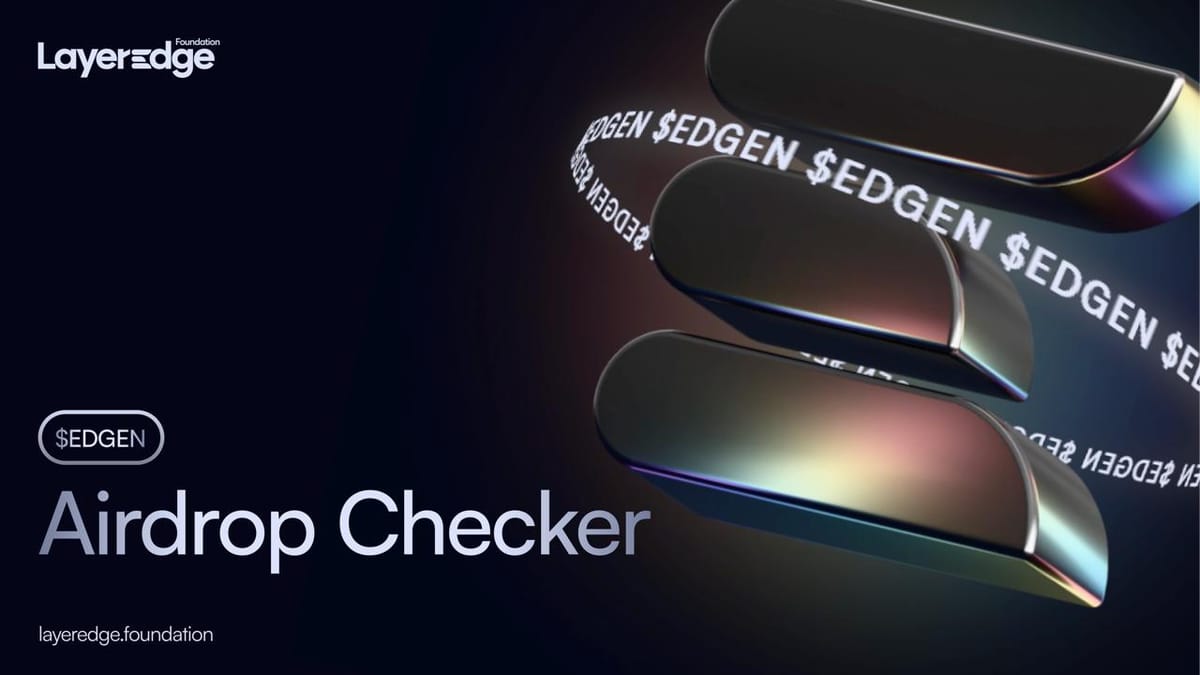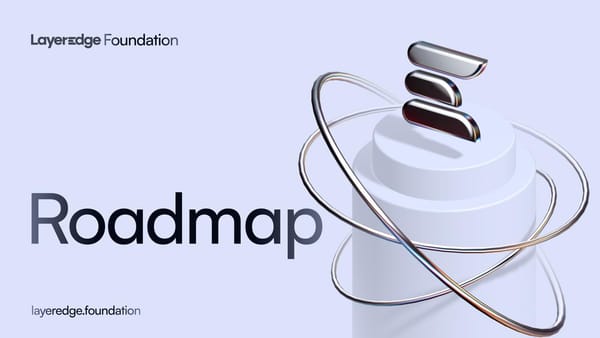The Airdrop One: Powering the People-Backed Internet

This was never meant to be just an airdrop. It was always about something bigger—infrastructure redistribution.
When we set out to build LayerEdge, the goal wasn’t to follow a playbook. But to create a system where the people who show up early and ran the nodes, verified the proofs, spread the word—didn’t just participate but own a piece of it.
Every point earned, every referral made, every proof verified—it all led to this moment. And with the EDGEN token launch now in sight, we’re proud to open the books and share how this first wave of the airdrop is being distributed.
This is a reminder that if you’ve been here since the beginning, you’re not just early—you’re part of the foundation.
You helped build this. This is our way of saying: we saw you. We remember.
Who Was Eligible for the Airdrop One?
The People-Backed Internet wasn’t built overnight. It took millions of sessions, real node uptime, and early belief on our vision. This airdrop is for people who showed up—for those who showed up before the noise, helped bootstrap the edgenOS, and made decentralized verification possible.
Here’s who qualified:
PoH-Verified Node Runners
At the core of LayerEdge are the people who ran nodes—not just to farm points, but to verify zk proofs every day through edgenOS.
Users who completed Proof of Humanity verification and earned node uptime points made up the backbone of this drop. Their rewards were based on:
- The total number of points earned through verified node activity.
- IP uniqueness to ensure sybil resistance.
- Additional weighting for OG Pledge holders who committed early.
This group alone represents over 68% of the final airdrop pool — the ones who helped verify the early chain of trust.
Verified Referrers
Growing a network takes more than running nodes. It takes spreading the word.
Users who referred others to join, onboarded them into edgenOS, and saw those users actually run nodes were included here. In the initial allocation, multipliers were used to reward top referrers. But in the final version, we leveled the field: every verified referral counted equally.
This ensured that referrals were real.
OG Pledge Pass Holders
When the vision was still in the making, a few stepped up and minted the first OG Pledge Passes.
This was more than a mint. It was a commitment. And those who did so received:
- A full return of their mint fee in EDGEN
- Additional weight in the node reward pool
This category continues to receive a full 25% of the airdrop pool, reinforcing that early support gets remembered.
AlphaEdgers
The Discord crew, the mods, the quiet contributors. The ones who sent in real time feedback, tested node builds, or helped others in the community with updates and tutorials.
This group received a dedicated flat reward.
Early Social Contributors
Crypto runs on culture. And LayerEdge’s earliest signal came not from TVL, but from Twitter threads, Discord memes, and the Telegram trenches.
A small but meaningful allocation was set aside for those who supported the vision when it was still being written—distributed across social platforms with a short 3-month vesting to ensure alignment.
Initial Allocation: Designed for Early Belief
Belief that decentralized verification could be run by people. Everything mattered from browser nodes mattered to uptime which enabled a new kind of network which was powered by everyday devices.
So when we first designed the airdrop, it was about showing up when there was nothing to gain but trust.
We set aside 8% of the total EDGEN supply—80,000,000 tokens—for the ones who helped us move forward.
This is how that belief translated into our initial distribution (now changed):
- 55.7% → PoH-Verified Node Runners Weighted by uptime, unique IPs, and OG Pass bonuses.
- 18.6% → Verified Referrals Early growth came from word of mouth. Referrers earned multipliers based on reach and activity resulting in scaling our network.
- 25.0% → OG Pledge Pass Holders They minted conviction and this allocation refunded their mint fee in full and gave added weight to their commitment.
- 0.5% → Early Social Contributors These were the users in Discord, Telegram, and X who kept the spark alive.
- 0.2% → AlphaEdgers The testers, the mods, and quiet contributors. Recognizing where it mattered.
But as momentum grew, we listened. We re-evaluated. And what came next was a shift—not in values, but in clarity and fairness.
We Heard the Community
As the campaign grew, so did the responsibility to get it right.
We took a deeper look—into node patterns, referral behaviors, and how contributions were recorded.
What we found reminded us why LayerEdge exists in the first place: to reward real participation.
We noticed some referral tiers growing disproportionately through patterns that didn’t reflect meaningful onboarding.
At the same time, real node runners—those with consistent uptime, unique sessions, and months of presence—deserved to shine through more clearly.
So we made a decision grounded in fairness:
- Referral rewards have been standardized — every verified referral now counts equally. It’s no longer about multipliers, but meaningful network growth.
- Node runner data has been refined with stricter filters — ensuring sybil resistance while preserving rewards for real uptime.
We didn’t reduce the airdrop pool. We realigned it. Same 8% of the supply—just reweighted to better reflect the contributions that built LayerEdge from the ground up.
Because when we say People-Backed Internet, we mean all people who showed up.
Final Allocation: Built for People
After zooming in, adjusting, and listening—what mattered most became clear: Verification is built by people.
So we didn’t shrink the airdrop pool. We refined it. We filtered out noise, flattened systems that could be gamed, and made space for the real ones to shine.
Here’s how the final airdrop distribution stands—reshaped by participation, not manipulation:
- 68% → PoH-Verified Node Runners: Now filtered with stricter IP clustering and sybil resistance, while keeping OG Pass weight intact. These are the devices that verified zk proofs across millions of sessions. They are the infrastructure.
- 6.3% → Verified Referrals: Multiplier tiers were removed. Everyone gets the same per-referral. Because we’re here to reward connections, not calculations. But we also saw around 200 accounts with unusually high verified referral counts—got into the highest multiplier leading to abonarmally high allocation.
To preserve fairness across the board, a cap of 4,000 EDGEN was enforced on such accounts (less than 200 accounts) with the highest verified referrals, standardising their multiplier and distributing the surplus referral pool back to node runners. - 25.0% → OG Pledge Pass Holders: Nothing changed. Because conviction should be met with consistency. They supported the vision when it was still just a promise.
- 0.5% → Early Social Contributors: Still vesting. Still meaningful. Still the ones who lit the spark when it was cold.
- 0.2% → AlphaEdgers: Quiet builders. No adjustments—just thanks.
The values didn’t change. But the weight shifted—towards uptime, towards real participation, towards people.
Because this is the People-Backed Internet—and when we say no contribution goes to waste, we mean it.
One User, One IP: How We Treated IPs
In a system built by people, we had to make a call that would anchor fairness into the drop itself.
We looked closely at IP data—and found something telling.
Out of the total airdrop set:
329,844 wallets came from 329,844 unique IPs — simple and direct.
But another 359,844 wallets came from just 72,897 IPs.
That raised a flag. To stay true to the 1 person = 1 reward principle, we applied a simple rule:
One IP = One User
If two or more accounts are on the same Wi-Fi network, rewards will be split between the accounts.
We made sure those who actually showed up got what they earned.
What This Airdrop Tells Us
68% of the airdrop went to real node runners — those who made edgenOS real through uptime, not speculation.
25% was committed to OGs who pledged and trusted the vision.
Referral multipliers were removed because growing the network is about people, not point-maximizing strategies.
Not a single EDGEN was wasted — every token in this drop stands for action taken and trust placed.
When we say People-Backed Internet, this is what we mean.
How to Claim — And What’s Next
Your $EDGEN is waiting.
You can check your eligibility at: airdrop.layeredge.foundation
Eligible participants can claim their airdrop in one of two ways:
Claim via CEX Pre-Deposit (Now Open Until June 1, 10:30 AM UTC)
Users on KuCoin, HTX, Gate, and Hashkey Global can pre-register to receive their airdrop directly to their exchange account.
Just submit your UID and exchange deposit address—and your $EDGEN will be delivered at TGE, no extra steps required.
Claim on Edgen Chain Mainnet (Opens at TGE)
If you wish to claim on-chain or missed the CEX pre-deposit window, don’t worry.
You’ll still be able to claim directly on LayerEdge’s Edgen Chain mainnet when TGE goes live on June 2. The process will be completely gasless for all eligible wallets.
Users who calim on-chain unlocks eligibility to earn up to 50% promotional APY by staking $EDGEN.
Simply verify your allocation at airdrop.layeredge.foundation and opt for claim your EDGEN on-chain directly to your wallet.
But this drop was just the beginning.
As we head into Phase III, we’re doubling down on the same values:
- edgenOS browser extension goes live
- A new point + referral system kicks off
- 1,000,000 EDGEN — 1% of total supply — is already reserved for our most loyal participants from Phase I and Phase II, ensuring they’re not just rewarded now, but continue to lead the way forward.
- 1 hour early access for our users on our community round on June 1st, 2025.
It’s a long-term shift in how infrastructure is built, distributed, and scaled—by people, for people.
Let’s keep building the People-Backed Internet.Together.




